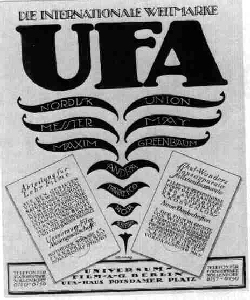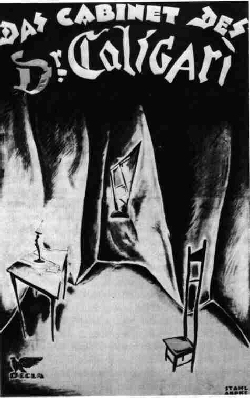

The Golden Age of German Film
WWI brought a new agenda for the German film industry. With the entry of
the U.S. into the war in 1917, Erich von Ludendorff, Quartermaster General
of the Army, concluded that more drastic measures should be taken to meet the
general wave of anti-Germany propoganda coming from the well-equiped studio
of its new enemy. On December 18, 1917, the German High Command formed
UFA (Universum Film A.G.), which brought together prominent financiers and
industrialists with the largest film companies in Germany. UFA's raison d' être was clearly propogandistic. As noted
by one film historian, "The official mission of UFA was to advertise Germany
according to German directives. These asked not only for direct screen
propoganda, but also for films characteristic of German culture and films
serving the purpose of national education".
UFA's raison d' être was clearly propogandistic. As noted
by one film historian, "The official mission of UFA was to advertise Germany
according to German directives. These asked not only for direct screen
propoganda, but also for films characteristic of German culture and films
serving the purpose of national education".
The intent of UFA was soon realized by Ernst Lubitsch with his production
of Madame Dubarryreleased in 1918. The film achieved a near
revolution in the art of film. Lubitsch did with the camera what no
previous German director had. Upon its release in the U.S. in 1920,
Madame Dubarry, retitled Passion, was acclaimed the most important European
picture since the Italian production of Cabiria. With Madame
Dubarry, Lubitsch emerged as a director of would stature and the German
film achieved its first breakthrough in the international market since the
Armistice.
In 1921, the Reich government divested itself of its UFA holdings, with the
Deutsche Bank acquiring its shares. Reconstituted as a private company, the
primary objective of UFA was to be the production of commercial films of high
artistic value that would be capable of competing on the world market,
especially the American.
Germany was in poor shape by the end of WWI. Many citizens were dying of starvation
as the country was faced with high inflation and widespread unemployment.
The anguish of the period was reflected in Fritz Lang's two-part film,
Dr. Mabuse der Spieler (Dr. Mabuse the Gambler), released in 1922. The
film depicts an unscrupulous criminal who gambles with lives and fortunes.
The Aufklärungsfilme "films about the facts of life" emerged during
this period. Most of these films were actually sex films, only thinly
veiled as education. Popular demonstrations and legal action against the
Aufklärungsfilme occured throughout Germany. The National Assembly
proposed the nationalization of the film industry which was rejected in
favor of a National Censorship Law, adopted in May, 1920. Under this law
children under twelve were prohibited from seeing films while children
between twelve and eighteen could only be admitted to films which had
been designated with a special certificate. No film could be prohibited due
to its content.
The most enduring of the films of the 1920's are those that came out of the
expressionist movement. As an artistic movement, German expressionism
antedated WWI. Film, the newest of the arts, was also the last to reflect
expressionism. Two definitive expressionist films are Das Kabinett des Dr.
Caligari (The Cabinet of Dr. Caligari), directed by Dr. Robert Weine in
1919-20, and Metropolis, directed by Fritz Lang in 1926-27.
 . Das Kabinett des Dr. Caligari, based on a
story by Carl Mayer and Hans Janowitz, suggests the darker aspect of expressionism
with its probing of insanity. The authors originally intended for the film
to serve as an allegory against insane authority as represented by the tyranny
of Dr. Caligari, but the film ends with the harmless doctor telling his piers
that he can cure his patient now that he understands the root of his own
psychosis.
. Das Kabinett des Dr. Caligari, based on a
story by Carl Mayer and Hans Janowitz, suggests the darker aspect of expressionism
with its probing of insanity. The authors originally intended for the film
to serve as an allegory against insane authority as represented by the tyranny
of Dr. Caligari, but the film ends with the harmless doctor telling his piers
that he can cure his patient now that he understands the root of his own
psychosis.
 Metropolis, directed by Fritz Lang in 1926, emphasizes the importance of the
spiritual as opposed to the material and the notion that through choas and
destruction a new and better world will come about. The overthrow of the
old order was an essential prerequisite for the coming of the "New Man" and the
establishment of the "Kingdom of Love". The final title reads: "There can
be no understanding between the hand and the brain unless the heart acts as
mediator."
Metropolis, directed by Fritz Lang in 1926, emphasizes the importance of the
spiritual as opposed to the material and the notion that through choas and
destruction a new and better world will come about. The overthrow of the
old order was an essential prerequisite for the coming of the "New Man" and the
establishment of the "Kingdom of Love". The final title reads: "There can
be no understanding between the hand and the brain unless the heart acts as
mediator."
The pure expressionism of Das Kabinett des Dr. Caligari and
Metropolis, although among the most famous of German films from the 20s,
was not characteristic of the several thousand motion pictures produced between
1919 and the end of the silent era. Although both were artistic and remain
the quintessential examples of cinematic expressionism, neither Das Kabinett
des Dr. Caligari nor Metropolis were commercial successes. And
while the German film achieved an international renown for the artistry of
selected motion pictures, the industry never rested on a firm financial basis.
This struggle between artistic expression and financial succuss would plague
the German cinema for years to come.
For some German filmmakers, success was measured by American popularity. Ernst
Lubitsch was the first of the major German directors to accept an American
assignment. He was asked by Mary Pickford (a popular American actress of the
20s) to direct Rosita. Friedrich Wilhelm Murnau's Der letze Mann
earned him an invitation to direct American films. Murnau's American work
consists of only four films: Sunrise (1927), The Four Devils
(1928), City Girl (1930), andTabu (1931). After completion of
Tabu, Murnau died in an automobile accident near Santa Barbara, California.
Besides Lubitsch and Murnau, many other German directors and actors entered
the American industy during the 20s, a trend that continues today.
Fritz Lang, director of Der müde Tod, Dr. Mabuse, der Spieler and
Die Nibelungen, was the principle German director to remain outside
the American industry during this first wave of immigration. Lang had no
desire to move to Hollywood. While visiting America, Lang told an interviewer
that while he admired the technical resources of the American industry, he
found American directors too commercial and less devoted to art than their
German counterparts. Lang clearly had a different idea regarding the potential of
film than did the American directors of the time.
Back to Homepage
The Formative Years
Third Reich Films
Post WWII Films
Emergence of the "New German Cinema"
Related Links
 UFA's raison d' être was clearly propogandistic. As noted
by one film historian, "The official mission of UFA was to advertise Germany
according to German directives. These asked not only for direct screen
propoganda, but also for films characteristic of German culture and films
serving the purpose of national education".
UFA's raison d' être was clearly propogandistic. As noted
by one film historian, "The official mission of UFA was to advertise Germany
according to German directives. These asked not only for direct screen
propoganda, but also for films characteristic of German culture and films
serving the purpose of national education".

 . Das Kabinett des Dr. Caligari, based on a
story by Carl Mayer and Hans Janowitz, suggests the darker aspect of expressionism
with its probing of insanity. The authors originally intended for the film
to serve as an allegory against insane authority as represented by the tyranny
of Dr. Caligari, but the film ends with the harmless doctor telling his piers
that he can cure his patient now that he understands the root of his own
psychosis.
. Das Kabinett des Dr. Caligari, based on a
story by Carl Mayer and Hans Janowitz, suggests the darker aspect of expressionism
with its probing of insanity. The authors originally intended for the film
to serve as an allegory against insane authority as represented by the tyranny
of Dr. Caligari, but the film ends with the harmless doctor telling his piers
that he can cure his patient now that he understands the root of his own
psychosis.
 Metropolis, directed by Fritz Lang in 1926, emphasizes the importance of the
spiritual as opposed to the material and the notion that through choas and
destruction a new and better world will come about. The overthrow of the
old order was an essential prerequisite for the coming of the "New Man" and the
establishment of the "Kingdom of Love". The final title reads: "There can
be no understanding between the hand and the brain unless the heart acts as
mediator."
Metropolis, directed by Fritz Lang in 1926, emphasizes the importance of the
spiritual as opposed to the material and the notion that through choas and
destruction a new and better world will come about. The overthrow of the
old order was an essential prerequisite for the coming of the "New Man" and the
establishment of the "Kingdom of Love". The final title reads: "There can
be no understanding between the hand and the brain unless the heart acts as
mediator."